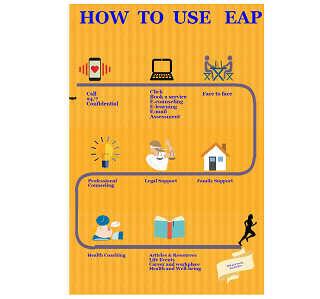Employee Assistance Program (EAP) for SME’s
By: Together Abroad 02-02-2015

What employer does not recognise it? Employees who suddenly come to work unmotivated, who dread a consultation with the manager, who do not or with great difficulty make customer meetings and deadlines. Everyday work situations that employees were previously able to handle that now provide a lot of stress – stress which translates to fatigue, depression that can eventually lead to a burnout. And you don’t know whether this has to do with work or perhaps personal situation of the employee.
Often the involved employee and the employer act only when it is too late. This situation comes with consequences: employees must follow long reintegration pathways and employers who need to divide the work incur additional costs. How nice would it be to avoid this and have productive and enthusiastic employees? This is where the Employee Assistance Program (EAP), with its unique approach, comes in. It achieves this in an effective and accessible manner.
What is EAP?
EAP is an extra bit of care that you, as an employer, can offer to your employees. This is because you recognise the importance of good work and want to support your employees with tailored programmes. Every employee of an organisation that has implemented EAP has direct access to professional support in the areas of stress, health, work-life balance, finance, legal affairs, youth and families – areas where issues can negatively affect the general welfare of the employee. Professional advisers and service providers of the EAP provide confidential coaching, counselling and legal assistance to the employee.
What does EAP yield?
An important point for EAP customers is that the interventions provided by the EAP yield demonstrable advantages for the organisation. There is probably no other organisational intervention that is in so much demand for the proof of its success. Interestingly enough, the EAP industry itself has taken many initiatives in recent years to provide such proof, the sector has also contributed to setting up an independent EAP Research Foundation, which studies the effects of EAP and the so-called "Return on Investment (ROI) of EAP's promotion and execution.
International literature was published on this subject (Moll, 2008 and 2014) and a ROI tool was even developed to make the 'profit of EAP' per specific company concrete. Although several studies show a diffuse palette, it is clear that EAP yields cost reduction. The most prudent approach is based on an ROI of 1:3: for each euro invested in the EAP, the employer sees a ‘return’ of three euros in increased productivity, and reduced sickness costs etc. Probably the reality is even much higher (Attridge, 2013).
Who is EAP for?
EAP provides benefits for both employees and employers. For the employee who has to deal with stress-related complaints, divorce, illness of a partner, family or financial problems, the EAP is available 24 hours a day and seven days a week by telephone. Also, his or her family may make use of coaching and counselling. If the employee needs personal conversations, these are also available through a nationwide network of professionals. The use of EAP is confidential so that the employee can freely discuss issues.
Companies like productive employees who use their energy to get business results. EAP also leads to cost savings through lower absenteeism. Moreover, companies can position themselves as innovative and social employers by offering EAP fringe benefits. Finally, EAP can provide clear management information (based on anonymous data) for strategic management and HR decisions.
By Igor Moll and Joris van Goudoever